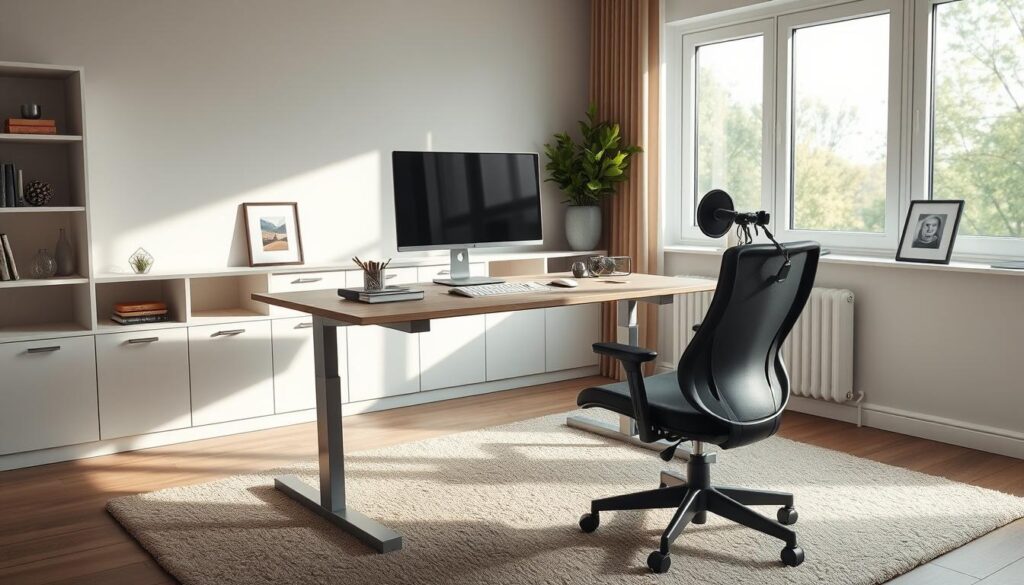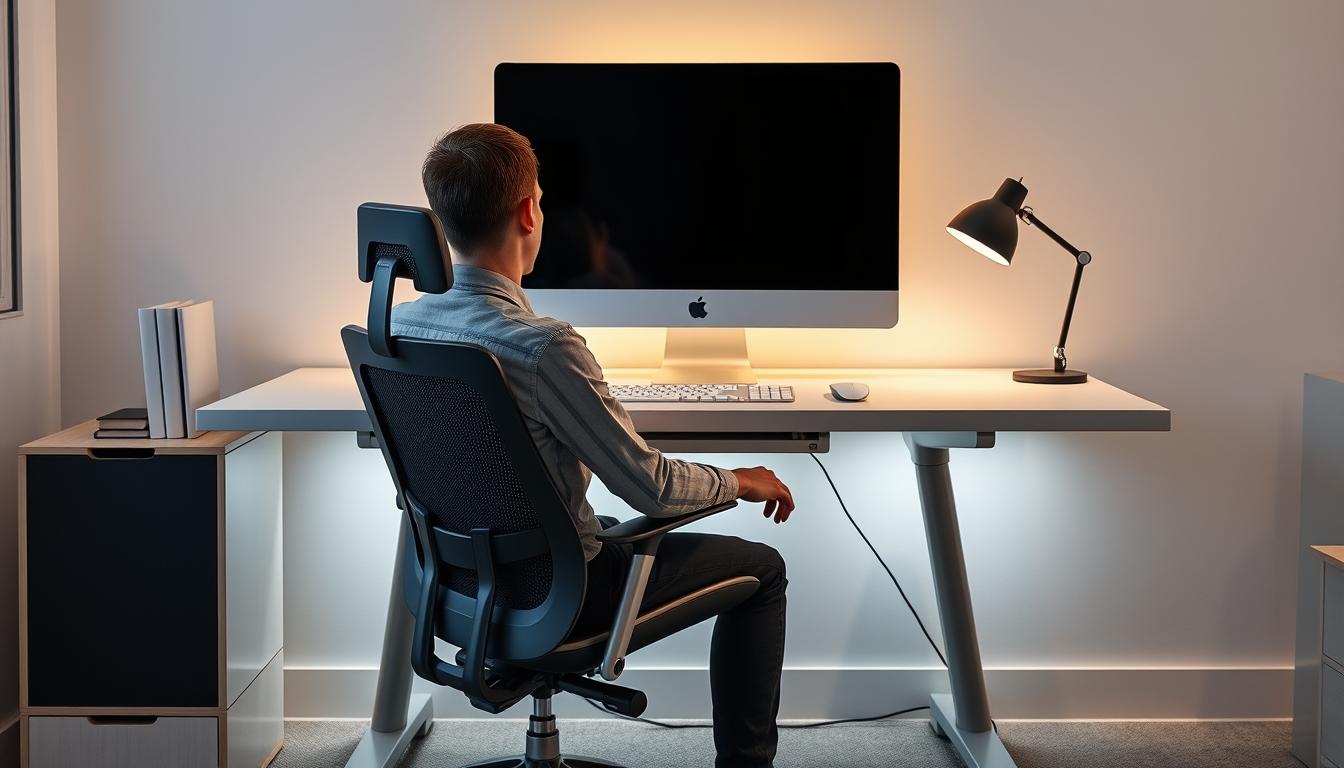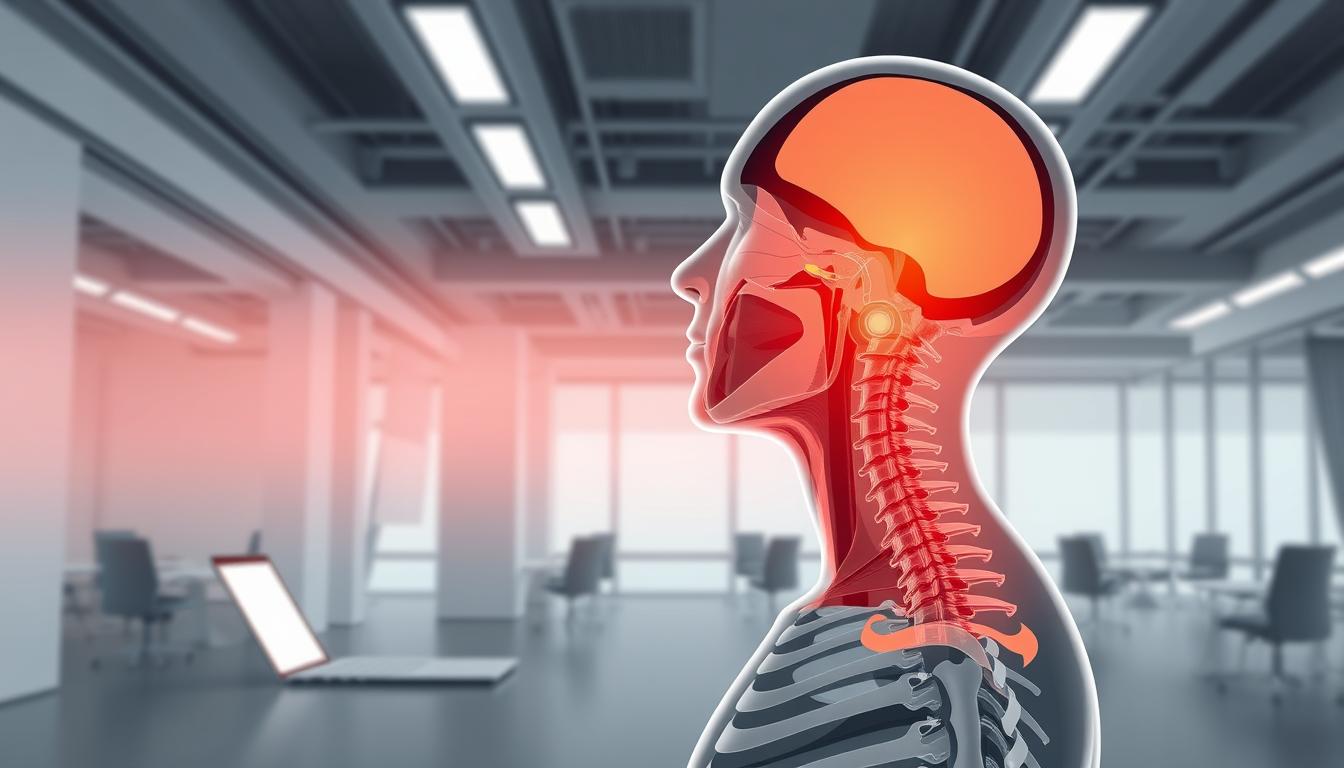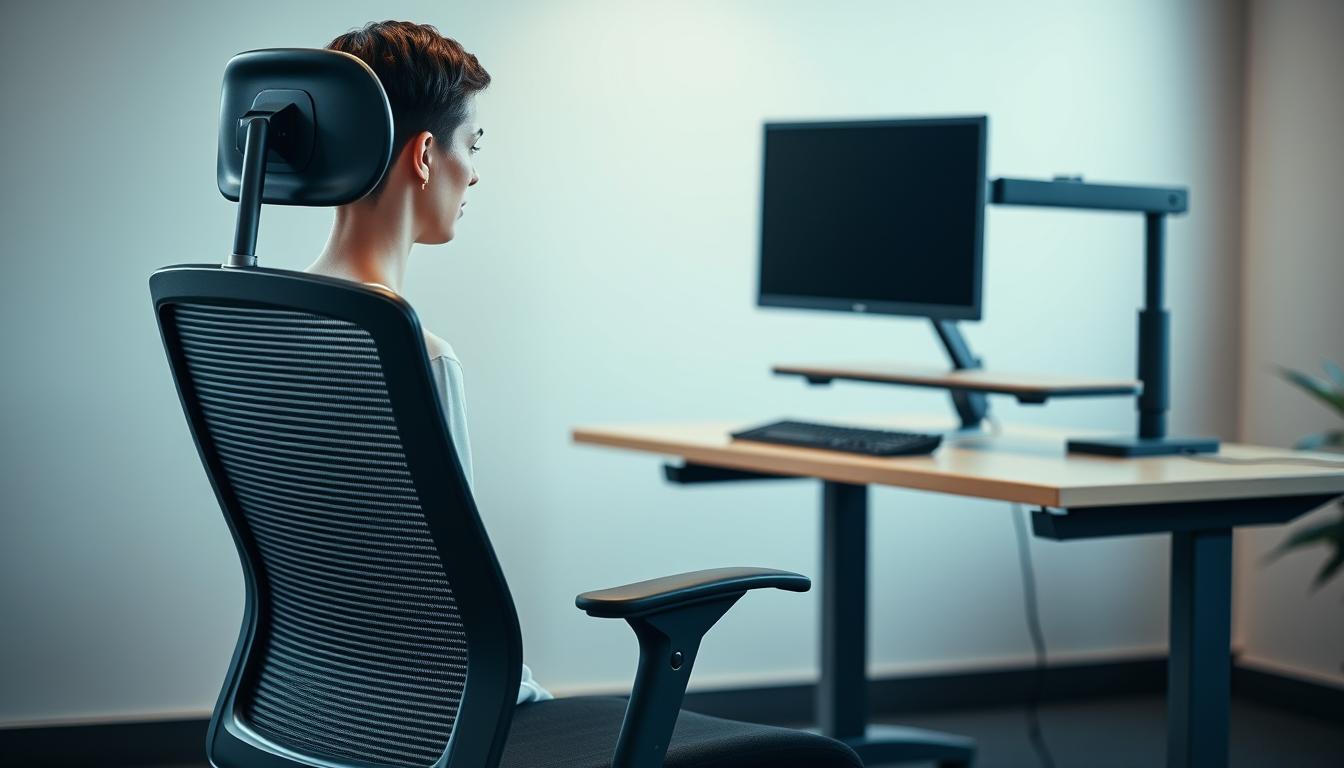In today’s world, being comfy at work is a must. Most of us use an ergonomic mouse and ergonomic keyboard all day. So, it’s vital to have them set up right. A good setup boosts your work and prevents pain or injury. We will explore top ergonomic solutions, with expert advice to make your workspace better for you.
Understanding the Importance of Ergonomics in the Workplace
Workplace ergonomics is about making sure job tasks fit the worker’s physical abilities. This keeps workers healthy and efficient. When equipment is not set up correctly, it can cause discomfort and fatigue. This often leads to pains and strains that can lower productivity and happiness at work.
Using a mouse and keyboard the wrong way can cause carpal tunnel syndrome and similar issues. The Mayo Clinic suggests that these problems can be avoided with the right ergonomic setup. For example, adjusting your desk height or how you use your mouse and keyboard can make a big difference.
Good workplace ergonomics help prevent injuries from long computer use and make a healthier work environment. Putting ergonomics first means fewer injuries and more productivity.
Choosing the Right Equipment for Ergonomics
Choosing ergonomic equipment is key to staying comfy during long desk hours. The right keyboard and mouse lessen strain and up your work game. While looking, consider what feels good and works well for you.
Selecting the Ideal Keyboard
Ergonomic keyboards vary in type and design, affecting how you type. A compact keyboard saves space, making it easy to reach your mouse. This lessens the strain from stretching for keys. Find keyboards that let you adjust angles and have soft supports for your wrists.
Identifying the Best Mouse for Your Needs
Even a simple mouse shapes how you hold your wrist and forearm. Vertical mice are great for keeping a comfy wrist position. They avoid twisting your wrist, stopping discomfort. Pick a mouse that fits your hand size and meets your daily needs. Always put comfort and how it works first in your choice.
Optimal Ergonomic Mouse and Keyboard Placement Guide
Setting up your desk the right way boosts your work and keeps your body healthy. Good placement of your keyboard and mouse helps avoid stress during long work hours. Start by putting your keyboard and mouse at elbow level, which helps keep your wrists straight.
Place these tools right in front of you to prevent twisting. This keeps your muscles engaged the right way, without extra strain. Keep a relaxed posture with your arms close to your side. It helps put your keyboard and mouse in the best position, making you more comfortable.
One more helpful tip is to keep your keyboard near your desk’s edge. It makes sure your arms can move freely and comfortably. Also, make sure your mouse is within easy reach, reducing shoulder stress. Doing this makes your workspace better for your health and productivity.
Proper Positioning of Keyboard and Mouse
Using your computer the right way can cut down on aches and help you work better. It’s key to place the keyboard and mouse just right. Having them at the best height and close enough keeps you comfy and stops strain during long work hours.
Positioning in Relation to Body Alignment
Make sure the keyboard is at the same level as your elbows. You should sit so your arms form straight lines or slant down a bit. This keeps your shoulders feeling good. For the mouse, keep it near so your arm isn’t stretching out. This way, you avoid strain and feel better as you work.
Placement Distance from the Edge of the Desk
Keep about 2 inches of space from the desk edge for wrist support while typing. This helps your wrists stay in a natural position, reducing discomfort. By getting the height and distance right, your whole body stays properly aligned, making workdays easier.
Maintaining Correct Wrist and Arm Posture
It’s key to keep a good posture while typing to avoid pain or injury. Having your wrists positioned right is very important. It helps prevent arm strain and makes you work better. Using things like wrist rests can make your workspace healthier.
Wrist Positioning to Avoid Strain
Correct wrist positioning aids your hands and lessens injury risk. It’s good to keep your wrists straight to spread out pressure. This lets you move more easily when using a keyboard or mouse.
Avoid bending your wrists too much. Taking regular breaks to stretch helps keep your wrists and fingers flexible and less tired.
Using Wrist Rests for Additional Support
Wrist rests are key for keeping a good posture while typing. Choose rests made from gel or foam for comfort and alignment. A well-placed wrist rest helps connect your arms to the keyboard without strain.
Check your setup often to make sure your wrist rests stay effective. Worn-out supports aren’t as helpful in keeping your wrists in the right position.
Adjusting Your Workspace for Comfort
Making your workspace comfortable is key for staying productive and healthy. Setting up your workspace right can help your posture a lot when you spend hours at your desk. Make sure your chair and desk heights are good, and use tools that help keep you in a good working position.
Chair and Desk Height Adjustments
First, set up your chair so you’re comfortable. Your feet should be flat on the ground, and your legs should be level. This helps with blood flow and lessens muscle pain. The height of your desk matters too; your arms should bend at 90 degrees when you’re typing. Getting your chair and desk to match up helps stop pain and is good for your body.
Utilizing Ergonomic Accessories
Adding special tools can make your desk even better for you. Use monitor stands to keep your screen right at eye level, which helps avoid neck pain. A keyboard tray can help keep your wrists from getting sore. These tools add to your workspace setup, making it a place that fights tiredness and helps you work better.
Best Practices for Frequent Users
Using smart strategies daily can make you more comfortable and efficient with a mouse and keyboard. Knowing how important breaks and keyboard shortcuts are is key to your well-being. These habits can greatly improve how you work every day.
Incorporating Breaks and Stretches into Your Routine
It’s crucial to take breaks often to avoid getting tired or strained. Breaks should be short and frequent to refresh your body and brain. Stretch a little during these times to ease your wrists, back, and neck.
Here’s how to make the most of your breaks:
- Set a timer to remind yourself to pause every hour.
- Get up and walk a bit to boost blood flow.
- Do easy stretches to loosen tight muscles.
Using Keyboard Shortcuts to Reduce Mouse Dependency
Learning keyboard shortcuts can save you time and help avoid hand strain. It’s a great way to up your productivity. Get to know the shortcuts for the apps you use most to speed up your tasks.
Boost your efficiency with these tips:
- Master the basics: copy, paste, and undo.
- Use shortcuts made for your specific software.
- Keep practicing to remember these commands better.
Avoiding Common Mistakes in Ergonomic Setup
Many people don’t realize they’re making their workspace uncomfortable due to simple ergonomic errors. Understanding these mistakes is key to improving both your work output and your health. Issues like wrong equipment placement or using the wrong accessories often cause ongoing discomfort. Fixing these issues is critical for a true ergonomic workspace.
Common Misalignments and How to Fix Them
Improper equipment setup often leads to bad posture and discomfort. To steer clear of these issues:
- Ensure that your monitor is at eye level to avoid neck strain and keep your spine straight.
- Place your keyboard and mouse close to your desk’s edge to maintain a comfortable arm position and lessen shoulder stress.
- Opt for a chair that allows you to adjust its height and has lumbar support for a better sitting posture.
When to Consider Professional Ergonomic Assessment
If you still feel uncomfortable after making changes, it might be time to see an expert. Ergonomic professionals can spot mistakes you might miss. They give advice that’s just right for you, making sure your workspace is both comfortable and efficient. Getting their help is smart, especially if work often leaves you in pain or tense.
Implementing Ergonomics at Home Office
Creating a productive and healthy home office is essential. Focusing on home office ergonomics boosts comfort and well-being. It involves setting up your workspace using key office ergonomics principles for a better work environment.
Adapting Your Home Setup for Maximum Comfort
For better comfort, your workspace needs some changes. Pay attention to these important parts:
- Ensure your chair supports your lower back and allows for adjustments to height.
- Position your desk so your elbows are at a right angle, parallel to the floor.
- Keep the monitor at eye level to prevent neck strain.
- Arrange frequently used items within easy reach to minimize unnecessary movements.
Investing in Ergonomic Office Solutions
Choosing high-quality ergonomic products improves your home office. Consider these options:
- Ergonomic chairs that promote good posture.
- Adjustable desks for different work positions.
- Wrist rests and footrests for extra support when used a lot.
- Sturdy monitor stands to keep screens at eye level.

Conclusion
Creating an ergonomic workspace is more than just a trend. It’s crucial for making work comfortable and boosting productivity at work and home. With the right equipment and best practices, you can dodge injuries and discomfort from using the computer too much. Ergonomics make your work life better and keep you healthy in the long run.
Checking your workspace regularly lets you make needed updates. Having things like adjustable chairs and keyboards, and taking short breaks are key. These actions help keep your workspace nice and productive. Together, they make a space where comfort and efficiency bloom, making every day tasks more enjoyable.
In the end, focusing on ergonomics is key to a work life that lasts and feels good. Start using these tips, and aim for a work area that is comfy now and keeps you healthy and productive for the future.



